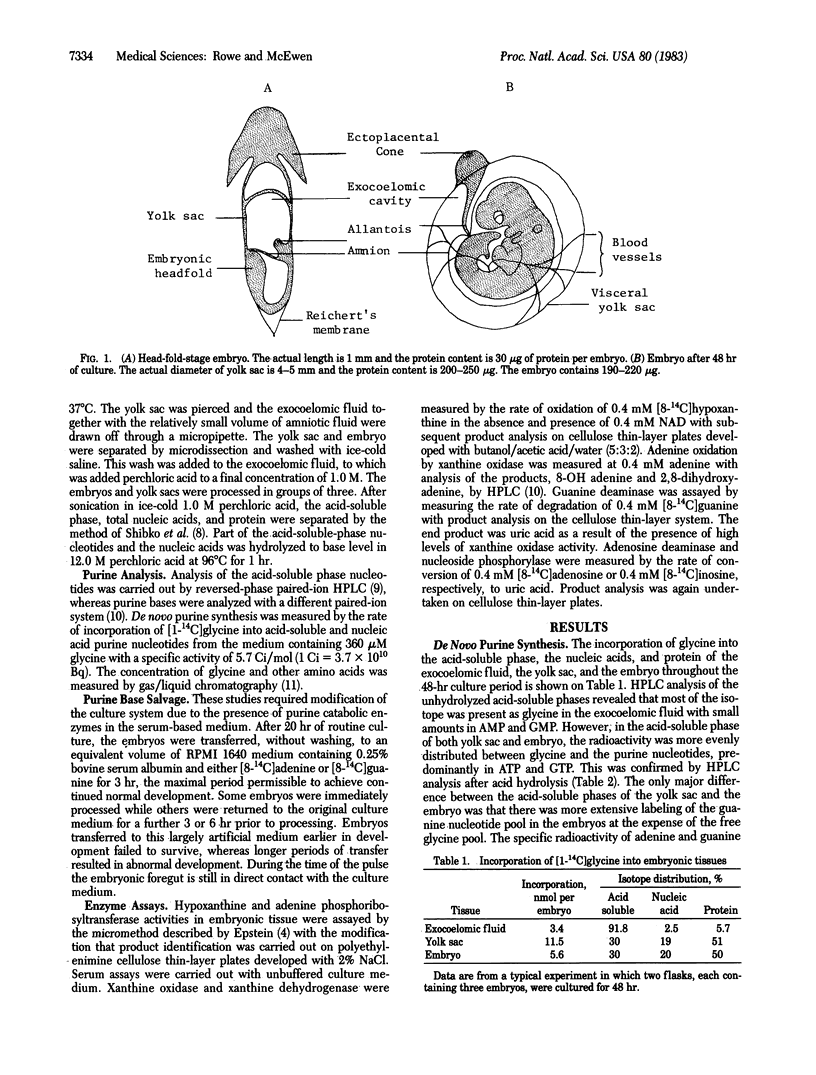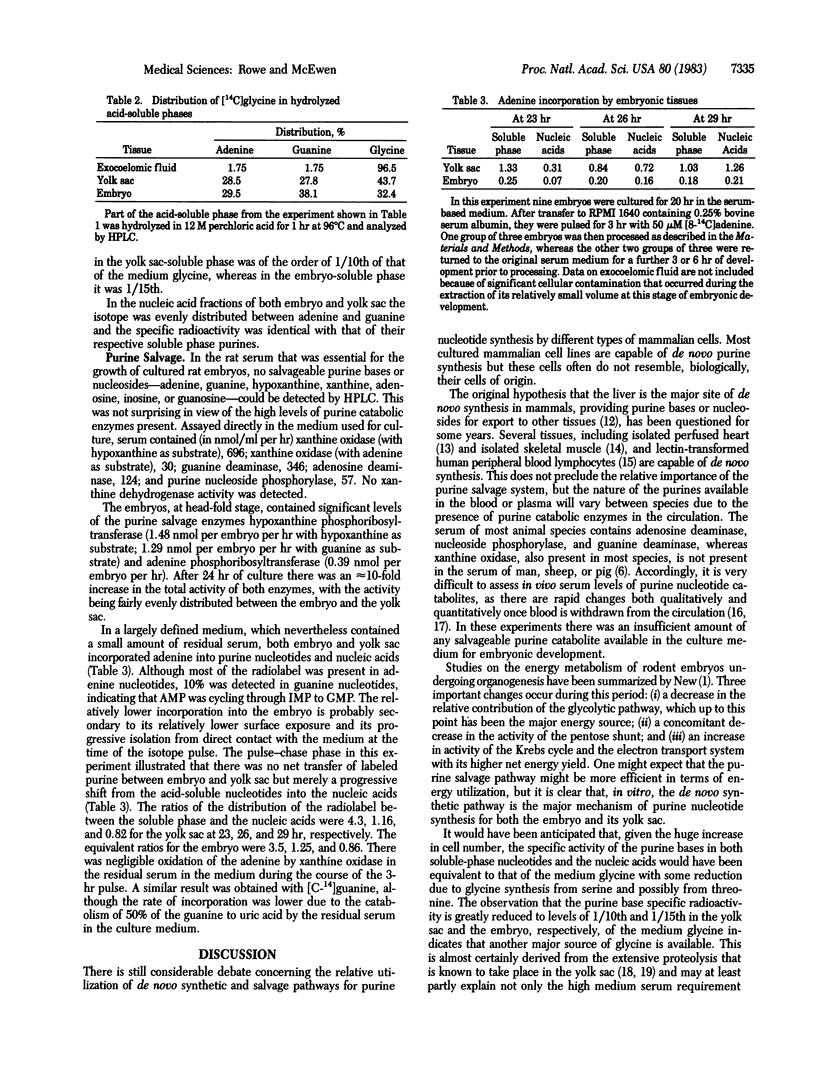Abstract
The cultured rat embryo undergoing organogenesis (9.5-11.5 days of gestation) together with its associated yolk sac synthesize purine nucleotides via the de novo synthetic pathway. Although both the embryo and its yolk sac contain significant levels of the purine base salvage enzymes adenine phosphoribosyltransferase and hypoxanthine phosphoribosyltransferase, the culture medium that consists largely of rat serum contains no measurable quantities of salvageable purine bases or nucleosides but high activity levels of purine catabolic enzymes. Short-term pulse-chase experiments with adenine and guanine, carried out under virtually serum-free conditions, confirmed that purine base salvage mechanisms were active and that there was no significant net transfer of purines between the embryo and its yolk sac. A comparison between the specific radioactivities of the [14C]glycine added to the culture medium for the studies of the de novo synthetic pathway and the purine bases in both the cellular nucleotides and the nucleic acids indicated the existence of a large glycine pool, which almost certainly was derived from the degradation of medium serum proteins by the yolk sac. Although there are no clear-cut data available on the in vivo plasma levels of purines that could be potentially utilized to meet the demands of the embryo, it is evident that the de novo pathway is adequately developed to meet these needs.
Full text
PDF



Images in this article
Selected References
These references are in PubMed. This may not be the complete list of references from this article.
- Al-Khalidi U. A., Chaglassian T. H. The species distribution of xanthine oxidase. Biochem J. 1965 Oct;97(1):318–320. doi: 10.1042/bj0970318. [DOI] [PMC free article] [PubMed] [Google Scholar]
- Audy J. P., Bastide P., Dastugue G. Répartition de la guanine-désaminase chez certaines espèces animales. Pathol Biol (Paris) 1969 Nov;17(21):975–977. [PubMed] [Google Scholar]
- Brown N. A., Goulding E. H., Fabro S. Ethanol embryotoxicity: direct effects on mammalian embryos in vitro. Science. 1979 Nov 2;206(4418):573–575. doi: 10.1126/science.573922. [DOI] [PubMed] [Google Scholar]
- Chen L. T., Hsu Y. C. Development of mouse embryos in vitro: preimplantation to the limb bud stage. Science. 1982 Oct 1;218(4567):66–68. doi: 10.1126/science.7123220. [DOI] [PubMed] [Google Scholar]
- Cockroft D. L. Nutrient requirements of rat embryos undergoing organogenesis in vitro. J Reprod Fertil. 1979 Nov;57(2):505–510. doi: 10.1530/jrf.0.0570505. [DOI] [PubMed] [Google Scholar]
- Desgres J., Boisson D., Padieu P. Gas-liquid chromatography of isobutyl ester, N(O)-heptafluorobutyrate derivatives of amino acids on a glass capillary column for quantitative separation in clinical biology. J Chromatogr. 1979 Feb 21;162(2):133–152. doi: 10.1016/s0378-4347(00)81907-6. [DOI] [PubMed] [Google Scholar]
- Epstein C. J. Phosphoribosyltransferase activity during early mammalian development. J Biol Chem. 1970 Jul 10;245(13):3289–3294. [PubMed] [Google Scholar]
- FRIDHANDLER L., ZIPPER J. STUDIES IN VITRO OF RAT YOLK SAC: BIOSYNTHETIC ACTIVITIES, RESPIRATION AND PERMEABILITY TO HEMOGLOBIN. Biochim Biophys Acta. 1964 Dec 9;93:526–532. doi: 10.1016/0304-4165(64)90336-8. [DOI] [PubMed] [Google Scholar]
- LAJTHA L. G., VANE J. R. Dependence of bone marrow cells on the liver for purine supply. Nature. 1958 Jul 19;182(4629):191–192. doi: 10.1038/182191a0. [DOI] [PubMed] [Google Scholar]
- McCairns E., Fahey D., Sauer D., Rowe P. B. De novo purine synthesis in human lymphocytes. Partial co-purification of the enzymes and some properties of the pathway. J Biol Chem. 1983 Feb 10;258(3):1851–1856. [PubMed] [Google Scholar]
- New D. A., Coppola P. T., Terry S. Culture of explanted rat embryos in rotating tubes. J Reprod Fertil. 1973 Oct;35(1):135–138. doi: 10.1530/jrf.0.0350135. [DOI] [PubMed] [Google Scholar]
- New D. A. Whole-embryo culture and the study of mammalian embryos during organogenesis. Biol Rev Camb Philos Soc. 1978 Feb;53(1):81–122. doi: 10.1111/j.1469-185x.1978.tb00993.x. [DOI] [PubMed] [Google Scholar]
- Rowe P. B., McCairns E., Madsen G., Sauer D., Elliott H. De novo purine synthesis in avian liver. Co-purification of the enzymes and properties of the pathway. J Biol Chem. 1978 Nov 10;253(21):7711–7721. [PubMed] [Google Scholar]
- Shibko S., Koivistoinen P., Tratnyek C. A., Newhall A. R., Friedman L. A method for sequential quantitative separation and determination of protein, RNA, DNA, lipid, and glycogen from a single rat liver homogenate or from a subcellular fraction. Anal Biochem. 1967 Jun;19(3):514–528. doi: 10.1016/0003-2697(67)90242-4. [DOI] [PubMed] [Google Scholar]
- Slowiaczek P., Tattersall M. H. The determination of purine levels in human and mouse plasma. Anal Biochem. 1982 Sep 1;125(1):6–12. doi: 10.1016/0003-2697(82)90376-1. [DOI] [PubMed] [Google Scholar]
- Tully E. R., Sheehan T. G. Purine metabolism in rat skeletal muscle. Adv Exp Med Biol. 1979;122B:13–17. doi: 10.1007/978-1-4684-8559-2_3. [DOI] [PubMed] [Google Scholar]
- Williams K. E., Kidston E. M., Beck F., Lloyd J. B. Quantitative studies of pinocytosis. II. Kinetics of protein uptake and digestion by rat yolk sac cultured in vitro. J Cell Biol. 1975 Jan;64(1):123–134. doi: 10.1083/jcb.64.1.123. [DOI] [PMC free article] [PubMed] [Google Scholar]
- Zimmer H. G., Trendelenburg C., Kammermeier H., Gerlach E. De novo synthesis of myocardial adenine nucleotides in the rat. Acceleration during recovery from oxygen deficiency. Circ Res. 1973 May;32(5):635–642. doi: 10.1161/01.res.32.5.635. [DOI] [PubMed] [Google Scholar]



